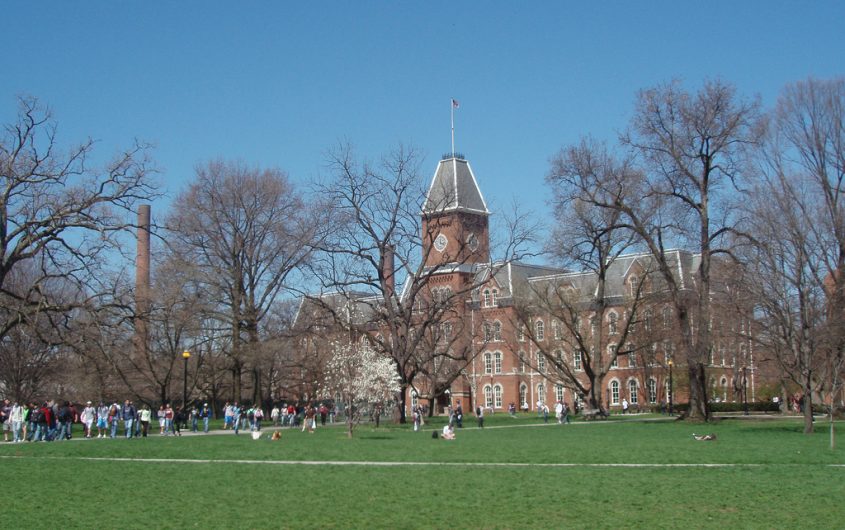
Jinjian Liang via Flickr
The U.S. and Germany Are Losing Cultural Ambassadors: Students Studying Abroad

Justin Leahey
Massachusetts Institute of Technology
Justin Leahey is the Massachusetts Institute of Technology’s MIT-Germany Program Manager. The program sends 80 – 100 students to Germany each year in a variety of capacities and fosters collaborations between faculty at MIT and at universities and research institutions across Germany. Previously, he worked at Harvard Law School and at the University of Freiburg. He holds a master’s degree in International Relations from Humboldt University of Berlin and a bachelor’s degree in International Relations and German Studies from Tufts University.
He is a 2018-2019 participant in AICGS’ project “A German-American Dialogue of the Next Generation: Global Responsibility, Joint Engagement,” sponsored by the Transatlantik-Programm der Bundesrepublik Deutschland aus Mitteln des European Recovery Program (ERP) des Bundesministeriums für Wirtschaft und Energie (BMWi).
Last month, the Institute of International Education and the U.S. Department of State’s Bureau of Educational and Cultural Affairs released their Open Doors 2018 report, which assesses the role of international education in the U.S. higher education sector. As the manager of a university program that sends U.S. students to Germany, and as someone with a deep personal interest in international education, I look forward to this report every year. This year, I must admit, I awaited the report with some trepidation—for incoming students to the U.S., it would be the report with the first full academic year after the 2016 election (academic year 2017-2018). While multiple factors influence students’ decisions to study aboard and where, the new political situation in the U.S. and its changing relationships abroad could have different influences globally, with a large, potentially negative, one on Germany.
Unfortunately, from the U.S.-Germany perspective, my fears were founded. Although globally the total number of international students in the U.S. to participate in higher education increased by 1.5 percent for the 2017-2018 academic year, the total number coming from Germany specifically decreased by 1.2 percent, the first decrease in five years. (Outgoing U.S. student data is behind by one year; for the 2016-2017 academic year, the number of U.S. students going to Germany continued its increase, by an impressive 5.2 percent). Even worse, however, is the fact that the total number of new international student enrollments in the U.S. declined by 6.6 percent. Germany-specific numbers aren’t available online, but they likely reflect a more precipitous decline. The 2017 Annual Report from the German Academic Exchange Service (DAAD) supports this theory—although more Germans than ever are studying aboard, “At the DAAD, the number of applications for one-year scholarships in the USA dropped by 20 percent” (p.90). From my conversations with colleagues in Germany, I have heard of even larger declines in applications for U.S. study abroad programs at German universities.
The top three factors that drive a decline are visa issues, the U.S. social and political situation, and competition from non-U.S. universities.
Why is this happening, and what does it mean for U.S.-German relations? The top three factors that drive a decline, according to the IIE, are visa issues, the U.S. social and political situation, and competition from non-U.S. universities. For the first two, there have been major changes, both real and perceived. The U.S. has increased visa requirements for legal immigration, including from visa waiver countries such as Germany, and the rejection rates and processing times have also increased. At the same time, according to the Pew Research Center, the percentage of Germans who have a favorable view of the U.S. dropped from 57 percent to 35 percent from 2016 to 2017, and confidence in the U.S. president dropped from 86 percent to 11 percent over the same year. For the third factor, at the global level, U.S. universities continue to enjoy high rankings, although non-U.S. universities are moving up.
The top three factors that drive an increase in enrollment—more active recruitment measures, growing reputation and visibility abroad, and more active outreach to admitted students—are also under threat. The U.S. government-sponsored Fulbright international educational exchange program, which among other activities drives recruitment and outreach abroad, was and continues to be under threat of massive funding reductions. The current U.S. administration’s support of unilateralism and challenges to the historical U.S.-Germany friendship seem unlikely to end soon.
The more Germans who return to their country connected to the U.S., the better for U.S.-German relations, especially in times of rising tensions between the countries, as today.
What does this decline of German enrollment in U.S. higher education mean for broader U.S.-Germany relations? I would argue that one fewer German student in the U.S. now is one fewer cultural ambassador for the U.S. in Germany for decades. A study abroad experience is more than just a purely academic exchange—it provides the opportunity to connect to a foreign country and to better understand its people and its way of life. The more Germans who return to their country connected to the U.S., the better for U.S.-German relations, especially in times of rising tensions between the countries, as today. Also, U.S.-German relations don’t exist in a vacuum. From a Realpolitik perspective, a highly motivated German student who goes to China instead of the U.S. for a study abroad opportunity is one who could be more supportive of Chinese versus U.S relations in Germany in situations in which they are at odds.
What can we do about this situation? In addition to supporting government-sponsored recruiting efforts abroad by protecting international exchange programs like Fulbright, private U.S. universities and other NGOs have the opportunity to increase their own recruitment and outreach methods. The good news is that I know there is a deep awareness within the U.S. international education community that our individual and collective recruitment efforts are now more important than ever. We are ramping up our collaborations with our partners in Germany and globally to bring more students to the U.S., and hope to slow or even reverse the trends seen in this year’s Open Doors report. We will see what the next year’s report brings!








